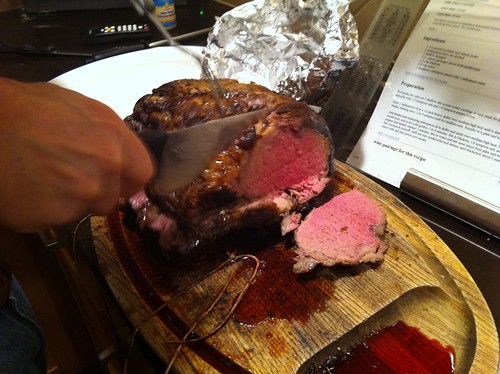Steve's Legendary Prime Rib
Christmas Dinner isn't something I ever ate growing up, being a Jew and all.
For the past few years, though, I've been visiting Craig's family in Bellingham, Washington and Craig's dad, Steve--a really excellent cook (see his apple pie)--has made some kind of roast to serve on the big night. And this year the prime rib that he made--a "well-marbled ten pounder," he tells me over e-mail--was so juicy and flavorful, it's entered the sphere of legend. We'll be comparing all the prime ribs we eat from now on to this one. What made it so good? How did he do it?
Two things made this prime rib such a success: (1) the meat Steve bought; and (2) the recipe that he used, a recipe from Cook's Illustrated that has you cook it low and slow.
First, the meat. Steve says that you want a "choice" grade rib roast. "Most places," he writes, "were 'select' which is a grade down." Again, you want a well-marbled ten-pounder.
As for the recipe, a lot of it is Steve's (the garlic, the spice rub) with the technique from C.I. He served it with a Madeira sauce that he found on Epicurious (recipe here; don't use that prime rib recipe, though, use Steve's.) There was also a horseradish sauce that Craig's sister Kristin made using jarred horseradish and sour cream. (You could also try mixing horseradish with creme fraiche, as Suzanne Goin does in her book.)
I realize that in January there's less occasion to cook such a huge slab of meat, but on a freezing winter's night invite a bunch of friends over for Prime Rib night. They won't say no. And if you have leftovers, sandwiches for lunch the next day! It's a win-win. And tell me this doesn't make you hungry:
Steve's Legendary Prime Rib
adapted from Cook's Illustrated
Ingredients:
One ten-pound, well-marbled "choice" grade prime rib roast
20 slivers of garlic (from about 4 to 5 cloves)
Your favorite spice rub (Steve used one from the store made specifically for Prime Rib)
1. The night before you cook it, cut 20 slits into the prime rib and insert a sliver of garlic into each. Season the whole roast with your spice rub. Place in the refrigerator and leave overnight.
2. Three hours before you're want to cook, remove the roast from the fridge and let it come to room temperature.
3. Preheat your oven to 200 degrees.
4. Heat a large roasting pan on two burners on medium-high heat. Sear the prime rib on all sides until nicely browned and about 1/2 cup of fat has rendered, 6 to 8 minutes.
5. Remove the roast from the pan. Set a wire rack in there and then set the roast on the rack. Season with lots of salt and pepper.
6. Place the roast in the oven and roast until a meat thermometer registers 130 degrees, inserted into the thickest part of the meat. (UPDATE: This year, 2011, we took it to 123 degrees for medium rare). It should take 30 minutes per pound (so about 5 hours.) Don't go by time, though, go by temperature.
[Side note: I bought Steve a probe thermometer for Christmas and that worked perfectly here. Just insert the probe thermometer into the thickest part, walk away, and monitor the temperature until it reaches 130.]
7. IMPORTANT STEP: when it's done cooking, remove to a cutting board and let rest for at least 20 minutes. If you don't, all the juices will run out.
8. After waiting 20 minutes, carve the meat and serve with the two sauces.
Here it is with a dinner roll and a gratin from my cookbook:
Thanks Steve for such a great dinner and for sharing the recipe!



